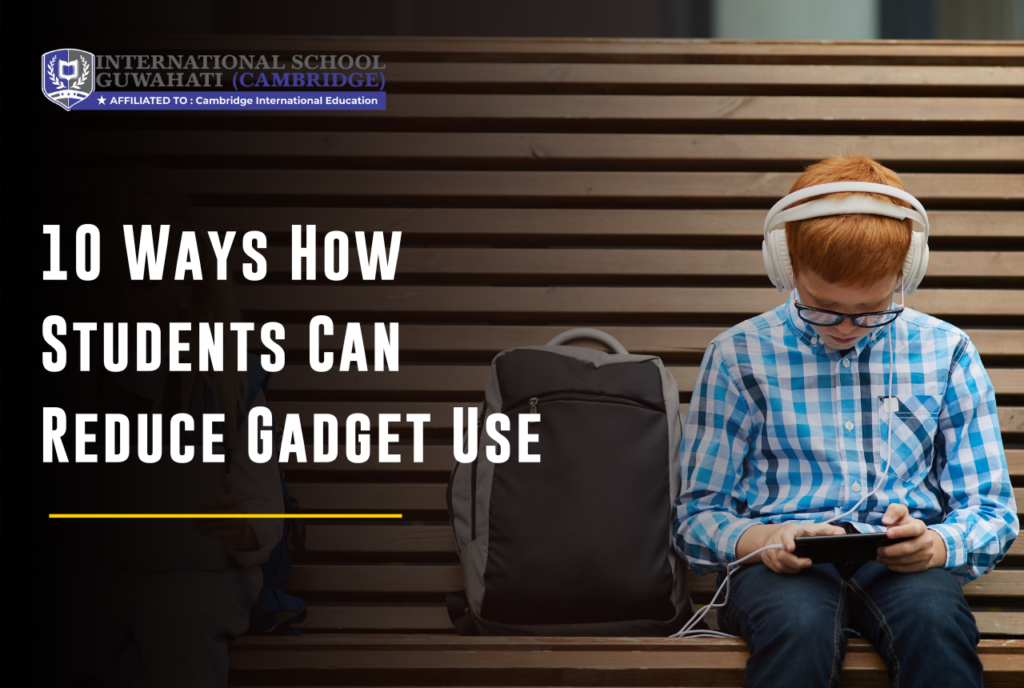![]()
Modern education is closely integrated with technology. Every student must have some knowledge about technology and gadgets to make the most out of the prevalent education system. While in the initial years of this type of education, accessibility was an issue, now there is a new one that we need to address. It is the excessive use of gadgets; therefore, in this article, we will discuss how students can reduce gadget use while keeping their education intact.
Medical experts have forever warned against the excessive usage of mobile phones and screen time. It affects students and adults all the same, distracting them, disrupting their ability to focus, and having health effects like poor eyesight and migraines. Improving focus in students is always a struggle and with the increasing role of technology in our day-to-day lives, it is becoming a bigger hurdle to overcome.
10 Ways How Students Can Reduce Gadget Use and Learn Better

1. Set Realistic Time Limits and Create a Schedule
Time is money; this is a real-world value you must understand. But, don’t you (and all of us) always find it slipping away no matter how hard you try? Well, that may be because you are not on a schedule or have a realistic time limit. Teachers can have sessions on time management tips for students with gadgets in school.
We have to understand that unrealistic time limits can affect our motivation. Therefore, it is necessary that we set realistic goals and realistic time limits for gadget usage too. Set a schedule for gadget usage (for your child if you are the parent) in which you need to extract everything you need for the study session and then set your gadgets aside. Try to keep them away and be less distracted. Remember, habits take time, so be patient.
2. Designate Gadget Free Zones and Times
While technology offers endless benefits, constant screen time can hinder focus and well-being. Creating gadget-free zones and times can be a game-changer!
Designate specific areas in your home, like the dinner table, as tech-free havens. Schedule device-free periods throughout the day, like during homework hours. These breaks increase concentration, sharpen social skills, spark creativity, and improve sleep quality. Discuss these zones and times with your parents (or with your children if you are the parent), informing them of the alternative activities they enjoy.
3. Utilise Parental Controls and App Blockers

Students or children always find a way to distract themselves with gadgets. With the advent of the internet, it has become an easier thing to do for them. Therefore, it is necessary that parents also exercise control over their online or gadget activities.
There are many apps and controls for parents to limit their children’s online activities and ensure their cyber safety such as Google Family Link and Net Nanny. These applications can actively reduce screen time for students and limit their usage of gadgets.
It is also important for parents to openly communicate these controls to their children. Coming to an understanding helps effectively implement these controls.
4. Find Alternative Activities and Hobbies
Students, explore hidden talents! Have you ever dreamt of becoming a musician, artist, or writer? Now’s the perfect time to explore! Dust off that old guitar, grab some paints or start journaling. You might be surprised at the hidden talents you discover. Dive into the world of books. Reading not only expands your knowledge but also ignites your imagination. Explore different genres, join a book club, or lose yourself in a captivating story. Books offer a gateway to countless adventures, all without needing to charge a battery.
The key is to find activities that spark your curiosity and creativity. Stepping away from gadgets allows you to connect with the real world, develop new skills, and create lasting memories
5. Practice Mindfulness and Digital Detox
Have you ever tried being mindful or meditation? It is a process of digital detox that helps us control our urge to get on our phones or scroll through Instagram. Studies have shown that meditation and digital detox increase concentration and focus, reduce distractions, calm the mind, and increase overall happiness.
It helps individuals become more present in the real world by improving their focus and decreasing their desire to multitask. This improved awareness enables individuals to identify the allure of electronics and pick other activities, thus lowering the desire for the constant stimulation that gadgets provide. Meditation teaches pupils how to manage their attention and make deliberate decisions regarding technology use.
6. Prioritize Your Sleep

Haven’t we always heard people tell us sleep is the cure for pretty much everything? Well, they are right! Here’s the truth: a good night’s sleep is your secret weapon against the pull of gadgets and the key to unlocking laser focus.
When you’re sleep-deprived, your brain struggles to resist distractions and retain information. But catch those sleep moments and amazing things happen. Sleep strengthens concentration, improves memory, and boosts willpower – all essential for resisting the lure of your phone.
7. Turn Off Notifications and Silence Your Phone
That sound of notification is very hard to resist. But try silencing your phone for a bit and listen closely to the sound of the real world and sheer focus, your concentration will skyrocket.
Notifications are designed to grab your attention. Each ping on your phone disrupts your chain of thought and makes you switch your tasks. By silencing them, you eliminate these distractions and can stay laser-focused on the work at hand. Checking notifications regularly also makes you give divided attention to your task, so it is better to silence your phone and other gadgets when you switch to work mode.
8. Reward Yourself with Gadget-Free Achievements
Motivation is crucial in everything you do. Therefore, in an attempt to build a strong habit such as staying away from gadgets as much as possible, you have to motivate yourself with rewards.
Try gadget-free achievements! Set goals that involve stepping away from your devices – like learning a skill or tackling a project. For rewards, you can give yourself an extra five minutes with your favorite game or ice creams after dinner, and so much more.
9. Seek Support From Family and Friends

When building a habit, it is harder to do it all by yourself. Seek support from your family and friends. Ask them to keep you on track by checking and regulating your screen time. You can also ask your parents to lock your phone and gadgets with passwords only they know. That way you will not be able to access them even when the urges strike.
10. Utilize Technology for Good: Educational Apps and Tools
Technology has made it easier for students to complete their studies and homework in a faster and easier way. Here are some apps and tools you can use to focus better and study more effectively.
- Forest: This app gamifies focus by letting you plant a virtual tree. Stay focused, and your tree thrives. Get distracted, and it withers!
- Freedom/Cold Turkey: Block distracting websites and apps for set periods, creating a tech-free zone for focused study.
- Focus Keeper: This app uses the Pomodoro Technique, breaking work into focused intervals with short breaks, promoting sustained concentration.
- Noisli: Create custom ambient soundscapes to block out distractions and enhance focus while studying.
- Insight Timer: Learn meditation techniques to improve concentration, reduce stress, and boost overall well-being for better study habits.
Benefits of Reducing Gadget Usage for Students

Unplugged life has its benefits; here are some of the prominent ones for students.
- Improved focus and concentration
- Better sleep quality
- Enhanced physical health and well-being
- Increased productivity and time management skills
- Stronger social connections and communication skills
- Reduced stress and anxiety
- Improved creativity and critical thinking skills
- More time for self-reflection and personal growth
Takeaway
Gadget usage is unavoidable for students in today’s modern education. Most of the material that students access is on the Internet that they need a gadget for. So, they need to have access to the newer technology for effective academic growth. But there is always a limit that parents and teachers need to set.
The above methods are a few of the other ways on how students can reduce gadget use. There can be many other approaches to building this habit. Tune into the customized approach that works for you and tap into mindfulness and an unplugged life.










